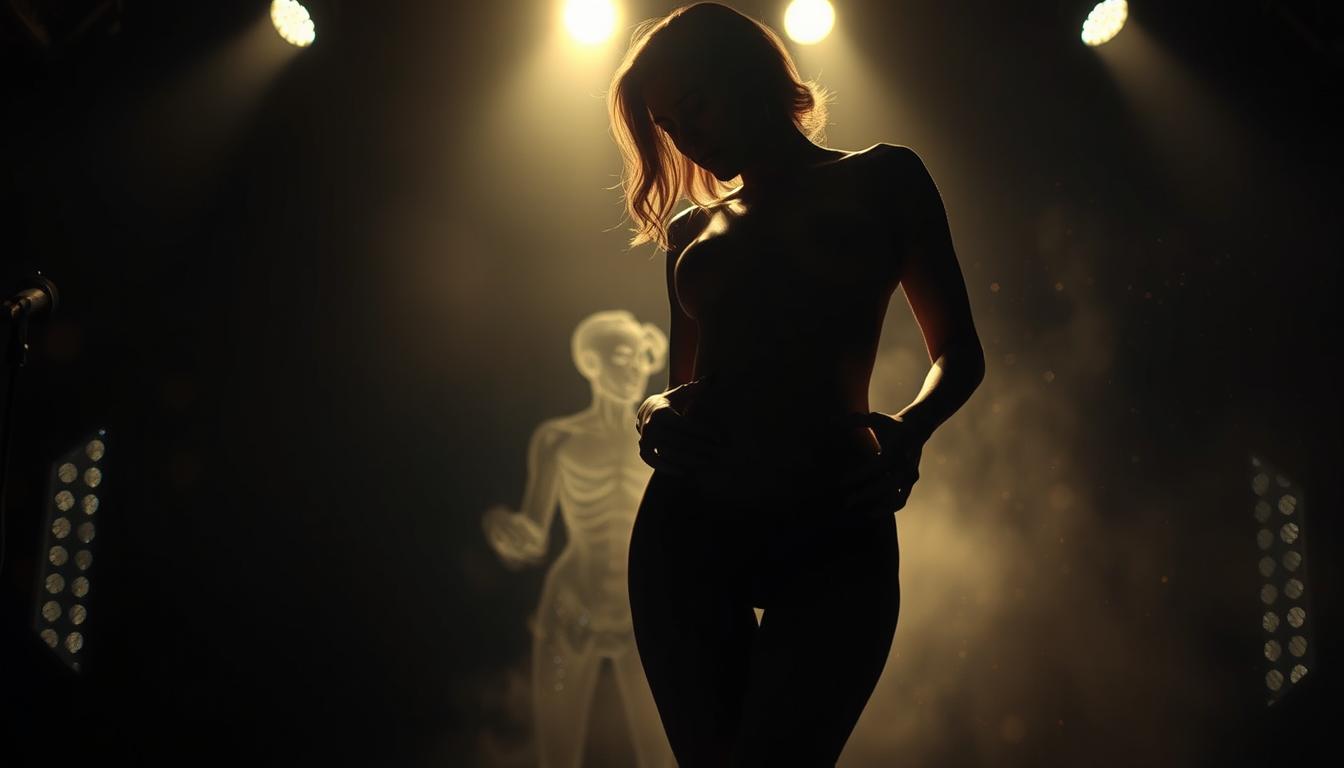Imagine it’s a late night in the early 2000s. Music videos are about to change forever. The screen flickers, showing a groundbreaking visual that pushes boundaries and challenges cultural norms. These erotic music videos are not just about skin. They’re about storytelling, artistic expression, and raw human emotion.
From Madonna’s “Justify My Love” to Beyoncé’s “Partition,” these videos have changed how we experience music. They’re more than just visuals—they’re cultural statements. They capture desire, power, and vulnerability in ways words can’t.
What makes these videos stand out isn’t just their provocative nature. It’s their ability to challenge societal expectations and redefine artistic boundaries. Each frame tells a story, each movement communicates depth beyond simple physicality.
Key Takeaways
- Erotic music videos challenge cultural boundaries
- Visual storytelling can be more powerful than lyrics
- Artists use sensuality as a form of artistic expression
- Music videos reflect evolving social attitudes
- Provocative content can spark meaningful conversations
Madonna – “Justify My Love”
In 1990, Madonna released a music video that changed the game. “Justify My Love” was a bold statement against societal norms. It pushed the limits of what was acceptable in media.
The video was shot in black-and-white at Paris’s Hotel Le Royal Monceau. It quickly became a hot topic. MTV banned it on November 27, 1990, due to its explicit content.
The video’s imagery sparked debates across the country. Madonna turned the ban into a marketing win. She released the video as a VHS single for $9.98, making it the best-selling video single ever.
Directed by Jean-Baptiste Mondino, the video was inspired by French cinema. It featured themes of bondage and group sexuality. It questioned why violence was more accepted than sexual exploration.
The song, written by Ingrid Chavez, Lenny Kravitz, and André Betts, reached number one on the Billboard Hot 100. This showed Madonna’s skill in turning controversy into success.
Britney Spears – “I’m a Slave 4 U”
In 2001, Britney Spears changed her image with “I’m a Slave 4 U”. This song was a big change from her teen pop days. At 20, Spears showed a more grown-up side with daring visuals.
The music video, by Francis Lawrence, is a key part of early 2000s pop culture. It was choreographed by Brian Friedman, with a focus on belly dancing. Spears wore revealing outfits, showing a new side of herself. The song reached No. 27 on the Billboard Hot 100, marking a new direction for Spears.
Her performance at the 2001 MTV Video Music Awards is unforgettable. It was voted the seventh-best VMAs performance by Rolling Stone readers. Billboard also named it one of the 100 greatest awards show performances. The song’s impact went beyond music, changing pop’s sound and look.
Originally, “I’m a Slave 4 U” was for Janet Jackson. But it became a key moment in Spears’ career. The song’s bold moves and daring visuals showed Spears as a grown artist, leaving her teen pop days behind.
D’Angelo – “Untitled (How Does It Feel)”
D’Angelo’s “Untitled (How Does It Feel)” changed the game in adult music videos. It came out on January 1, 2000, and quickly became a big deal. It pushed the limits of what we see in mature music videos.
The video shows D’Angelo without a shirt, in close-ups that changed how men are seen in videos. It got over 12 million views on YouTube. It drew in women by flipping the usual sexy video scripts. D’Angelo’s openness and change made the video unforgettable.
The song was a hit, reaching number 25 on the Billboard Hot 100 and winning a Grammy. The video got four Video Music Award nods, including best video. It showed how close-up shots can make a big statement in music videos.
Rolling Stone ranked the song 51st in the 100 Best Songs of the Decade. This solidified its place in music history. The video’s style and emotion set new standards for music videos, marking a key moment in adult music video art.
Rihanna – “S&M”
Rihanna’s “S&M” video hit the music scene in 2010. It pushed boundaries with its bold visuals. The video turned controversy into a statement about fame, sex, and media.
The video was part of Rihanna’s fearless career. She mixed sex and media critique in her work. Her use of color, props, and dance explored themes of power and perception.
The video’s energy left critics and fans stunned. Rihanna mocked media by gagging journalists. This turned controversy into satire. It made viewers think differently about sex, media, and art.
“S&M” showed Rihanna’s knack for pushing limits. The video sparked talks and showed her power in art. It was a statement on personal freedom and media control.
Chris Isaak – “Wicked Game”
Chris Isaak’s “Wicked Game” changed the world of sensual music videos. Released in 1989, it featured Isaak and supermodel Helena Christensen. The black-and-white video captured everyone with its emotional depth and stunning visuals.
The video, directed by Herb Ritts, is a classic of sensual music videos. Shot on a windswept beach, it showed Isaak and Christensen in passionate scenes. Their chemistry was undeniable, making the video unforgettable.
By 1991, the video had won big at the MTV Video Music Awards. It was ranked No. 13 on VH1’s “100 Greatest Videos” and No. 3 on NME’s list. This success made Isaak a global star.
The song’s rise was incredible. It started off unnoticed but became a hit after being in David Lynch’s “Wild at Heart”. It hit No. 6 on the Billboard Hot 100 and topped charts worldwide.
“Wicked Game” is a key moment in adult-oriented music videos. It shows that sensuality can be both artistic and captivating.
George Michael – “I Want Your Sex”
In 1987, George Michael released a music video that changed the game. “I Want Your Sex” was a bold move that sparked big talks about sex and health. It was a time when AIDS was a major concern.
The video was too much for some, causing a stir. MTV only played it late at night. Many radio stations refused to play the song. But Michael’s message was clear: sex is a part of life, and we should talk about it safely.
The song hit #2 on the Billboard Hot 100 and became a hit. The video showed scenes that were new for pop music. Michael wanted to talk openly about love and sex in a responsible way.
Some critics said the song was too explicit. But Michael’s message reached many. “I Want Your Sex” became a landmark in music videos, showing the power of honest talk about sex.
Beyoncé – “Partition”
Beyoncé’s “Partition” video is a bold step in music visuals. It was released in 2013 as part of her visual album. The video is set at Le Crazy Horse in Paris, known for its daring acts.
The video mixes burlesque with personal stories. It shows Beyoncé’s control over her image. She moves between her public and private sides, challenging what we expect from women in entertainment.
The video’s black-and-white look adds depth to its sensual scenes. It makes the video more than just a visual treat. It’s a powerful statement on female power and sexual freedom.
With scenes of her and JAY-Z, “Partition” is more than a video. It’s a bold statement on female empowerment and sexual freedom. It changed how we see pop culture.
Beyoncé released the album on iTunes only, showing her innovative spirit. “Partition” stands out as a track that turns controversy into art.
Kylie Minogue – “Slow”
Kylie Minogue’s “Slow” was a game-changer in 2003. It was the lead single from her album “Body Language.” The song showed Minogue’s skill in making sensuality look sophisticated through simple visuals.
The video was shot at Barcelona’s Piscina Municipal de Montjuïc. It features Minogue in a sun-kissed pool scene. She’s surrounded by shirtless dancers, delivering a performance that mixes dance with sexual energy.
“Slow” marked a turning point in Minogue’s career. It hit number one in Australia, the UK, and Spain. It also topped the Billboard Dance Club Play chart in the US, proving her global appeal.
The song’s success wasn’t just about the charts. It was nominated for Grammys and Ivor Novello Awards. “Slow” stands out for its sultry visuals and catchy sound. It’s a key moment in Minogue’s career, showing her talent for creating bold yet elegant music.
Robin Thicke – “Blurred Lines”
In 2013, Robin Thicke’s “Blurred Lines” changed the game with its bold visuals. The video sparked heated debates on consent, objectification, and gender in media. It topped the US Billboard Hot 100 for 12 weeks, breaking records.
The video, with nearly nude women and fully clothed men, drew heavy criticism. Universities in the UK, like University College London, banned it from events. They saw it as too explicit and sexist.
Despite the backlash, “Blurred Lines” was a huge hit. It was certified Diamond by the RIAA, showing it sold 10 million copies in the US. It also reached number one in 25 countries and sold 1,472,681 copies in Britain, making it the best-selling single of 2013.
The video’s impact went beyond sales. It started a big conversation about pop culture representation. Critics and young feminists argued it showed harmful stereotypes, yet claimed to challenge them. This debate changed how we view and talk about music videos.
Shakira – “She Wolf”
Shakira’s “She Wolf” music video is a bold step in risqué music visuals. Released in 2009, it showed her talent in mixing sensuality with unique choreography. This made the video a hit worldwide.
The video’s idea is Shakira becoming a wolf, symbolizing female power and emotion. Her dance skills and style made her a standout in Latin pop music.
Shakira has made many videos with over 100 million views each on YouTube. “She Wolf” was a hit for its fresh take on music videos. It showed a strong and bold side of feminine energy.
The video’s style was different from usual pop music videos. It used symbols to show inner change and basic instincts. It sparked talks about women in music and videos.
Wrapping Up: Top 10 Most Erotic Music Videos of All Time
The world of erotic music videos has changed a lot over the years. It has pushed the limits of what we see and think. These videos have mixed music, sex, and art in new ways.
Stars like Rihanna, Madonna, and George Michael have made big impacts. They’ve shown real human desire in their videos. Their work is more than just fun; it’s about freedom and being true to oneself.
These videos are not just about shocking us. They show how our views on sex, gender, and freedom are changing. By facing taboos and celebrating our feelings, these artists have given us something to think about and enjoy.
Today’s musicians are inspired by these pioneers. Their work keeps the spirit of erotic music videos alive. It shows us that art can challenge, teach, and celebrate our complex feelings about sex.




